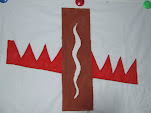NOT-VIOLENT TERROR
41 Tiresias’ Revenge (I)
How did the seed of The “more-equal-than-others” men’s lodge gain the upper hand over the seed of the populists? Various scenarios are possible. What follows is my attempt to see the elements of society, stiffened in limb and brain already in Sophocles’ time by unhealthy traditions and pretensions of the ruling class, deal with the problem. The unhealthy elements crystallize around the figure of Oedipus, a name I sometime convert to Jahnis-John. The events take at a place in classic Thebes, but are flexible enough to allow allusions to Latvia and Riga of today.
Tiresias’ Revenge
© Eso Anton Benjamins, 2009
A play based on Sophocles’ “Oedipus Rex”
Five Acts
Introduction Tiresias’ Revenge is a rewrite of Sophocles play “Oedipus King”. It shows that there is more than meets the eye to the play and the riddle it poses.
An actor friend who read my version of the story of Oedipus did not comment on the interpretation of the play (the theme of human sacrifice is, after all, a formidable subject), but commented on the rapid sequence of deaths in the last act. The actor wondered how a director would present to the audience the death of ten people in a succession that makes one want to say “Enough already with dying!” I understand. But these ten deaths (and perhaps more) are the children of one father, three deaths for his own children, the rest scattered about relatives and relations. All for one reason: Oedipus does not risk his life when he is not yet responsible for it, and self-sacrifice does not occur to him when he is old enough to think about it.
It is for the reader to decide if my thesis of what lies behind Sophocles’ intentions is the traditional uninteresting riddle (the Sphinx and all that), or whether the riddle is a clever way of disguising what the ruling orthodoxy considers essential to suppress, but the populists believe must be preserved at all cost.
Prologue The event, the telling of the story (by way of speech, body movement, sound, and spectacle) takes place before the castle of Thebes, perhaps the castle (pils) of Riga. To the right of the stage, close to an altar, near a high-standing, three-legged cauldron, stands a priest murmuring silent prayers. To the left of the stage sits Queen Ismene. The queen is very old. Before her stand or sit citizens of Thebes-Latvia.
Chorus (as it turns the palms of its hands up in a gesture of receiving):
Dearest Queen Ismene,
we are impatient to hear the story.
Tell us what ails Latvia.
We want to be healed.
These blogs tend to be a continuum of an idea or thought, which is why—if you are interested in what you have read—you are encouraged to consider reading the previous blog and the blog hereafter.
If you copy this blog for your own files, or to be forwarded, or its content is otherwise mentioned, please credit the author and http://esoschronicles.blogspot.com/


No comments:
Post a Comment